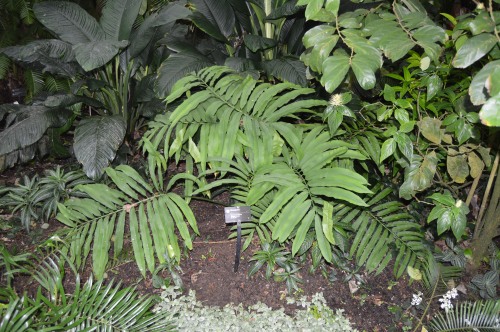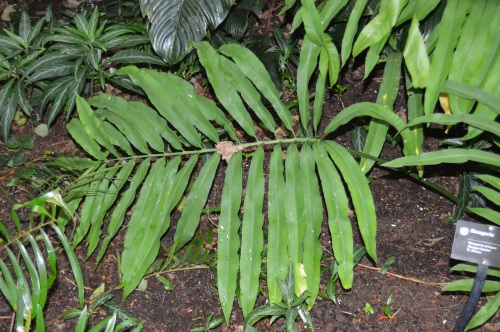Looking like a fern when cones are absent, Stangeria eriopus is a cycad endemic to Southeastern Africa found either in sunny grasslands (where there is typically only one leaf per plant) or densely shaded inland forests (where up to seven leaves may be present at one time). This is also the only species in Stangeria and one of two genera in Stangeriaceae, the other being Bowenia with two northeastern Australian species with bipinnate leaves.
Stangeria eriopus (Stanger’s Cycad, Natal Grass Cycad)
Family: Stangeriaceae
Subspecies: none
Native: South African (Natal) grasslands or inland forests within 50 kilometers of the coast
Hardiness Zones: 9-10
Height: typically under 2m
Diameter: stem to 20cm, spread overall to roughly 3m
Root System: large, tuberous, fleshy, branching
Growth Rate: slow, producing typically four leaves annually (no cataphylls produced though)
Age: very long-lived, to possibly hundreds of years, but can cone early as four years
Deciduous: no
Monoecious/dioecious: dioecious (either male or female)
Tolerates: light and heavy soils, highly variable (but constant!) light levels, light but very short and inconsistent frosts (down to 20F or -6C)
Problems (major): typical cycad ailments including root rot in overly wet soils
Problems (minor): intolerant of salt spray, mealybugs
Poisonous: yes, entire plant (particularly leaves and seeds)
Soil requirements: requires well-drained soils, naturally grows in sandy, granite, or heavy clay soils, prefers frequent fertilizer and compost application
Air requirements: tolerant of hot and humid conditions
Watering requirement: moderate (allow drying out before watering again), strong water jets or powerful streams will damage the foliage and roots
Sun requirement: full sun to heavy shade
Leaves: very fern-like, initially circinate and erect, arching with age, glabrous, emerge singly, pinnate, petiole base “wooly” 0.25-2 meters long; leaflets non-articulate and bases not persistent, large and fleshy stipules, foled, cataphylls absent, linear-lanceolate, decurrent on rhachis, prominently toothed and wavy margins, to 40 leaflets per leaf
Cones (male): cylindrical, tapers at apex, to 25x4cm, emerge terminally, few per plant at one time, produced year-round
Cones (female): ovoid, round tip, to 18x8cm, emerge terminally and singly (new growth continues afterwards due to new meristem formation), produced year-round
Seeds require stratification: no
Seed dispersal: 33x22cm radiospermic and ovoid seeds with purple/red sacrotesta dispersed by vertebrates
Form: fern-like
Trunk: subterranean, carrot-shaped, branching up to 10 offshoots/pups, to 20cm wide
Notable characteristics:
Initially placed in the fern genus Lomaria, partly because the first collected specimen was sterile and the leaves look very close to Oleandra distenta. This cycad,unlike nearly all others, does not produce heat from its cones. Sex changes have been observed in this species. Like many other cycads, it is listed as vulnerable by the IUCN.
Uses:
These are extremely heavily collected in South African regions, especially using the roots and stem for medicinal or cultural practices. Cuttings can be made by removing part of a stem and any attached leaves; proper watering and fertilizers should permit a healthy root system to develop within 18 months.
Sources used:
- Cycads of the World (David L. Jones, 2002)
- http://www.plantzafrica.com/plantqrs/stangereriop.htm
- http://www.iucnredlist.org/details/41939/0
- http://www.botanicwonders.com/Feature-Stangeria-eriopus.html
- http://www.conifers.org/st/Stangeria.php
- http://florawww.eeb.uconn.edu/199600016.html
- http://www.ucmp.berkeley.edu/seedplants/cycadophyta/stangeriaceae.html
- http://www.onlineplantguide.com/Plant-Details/4654/
 Stangeria eriopus form at the Missouri Botanical Gardens
Stangeria eriopus form at the Missouri Botanical Gardens
 S. eriopus leaf at MoBot (December)
S. eriopus leaf at MoBot (December)
All of the images provided were taken by me. They may be used for educational/informational purposes only, provided that this article/online journal is appropriately cited first.
